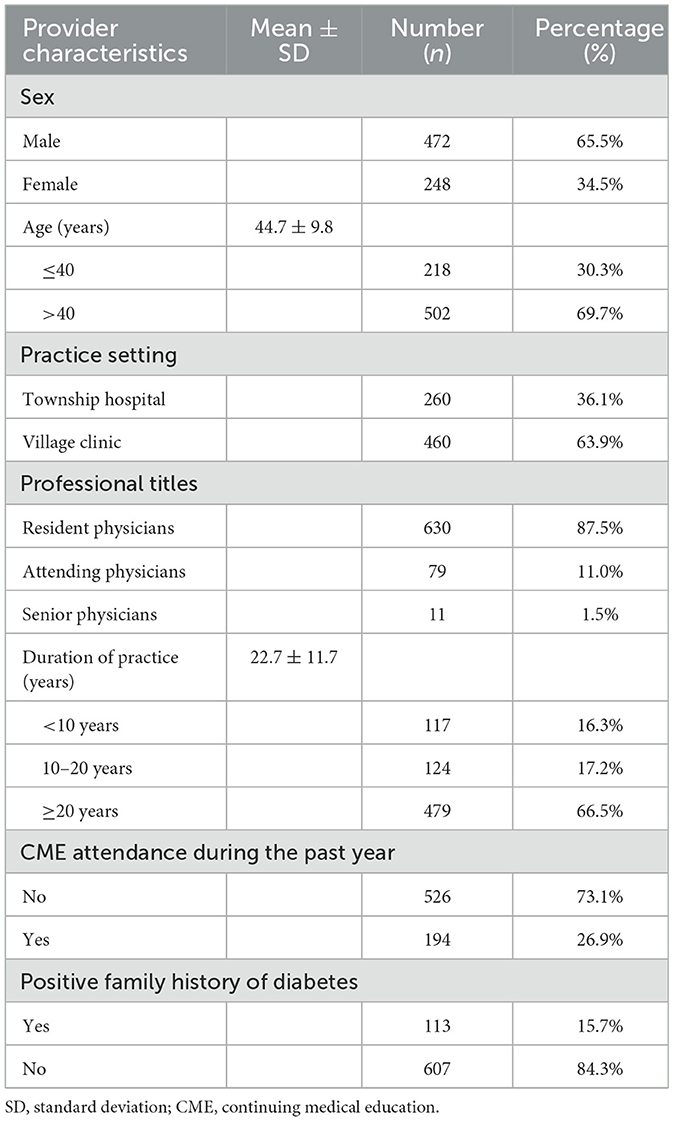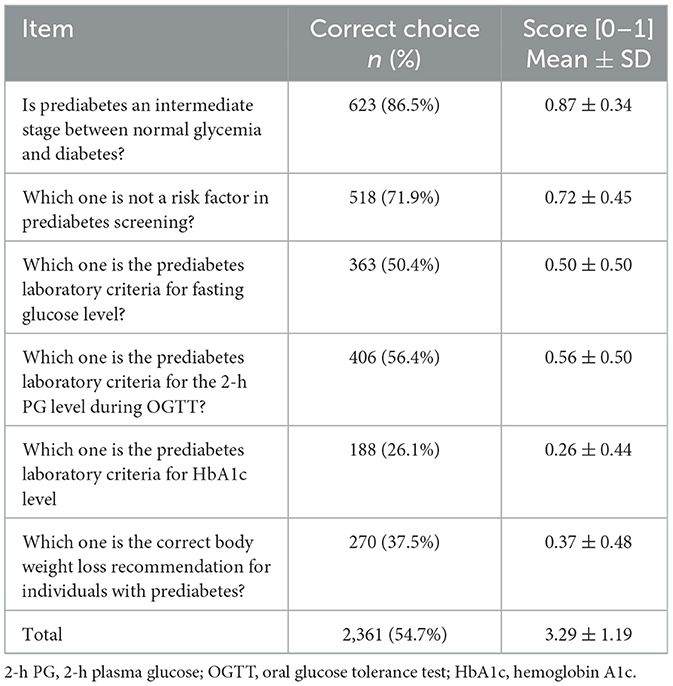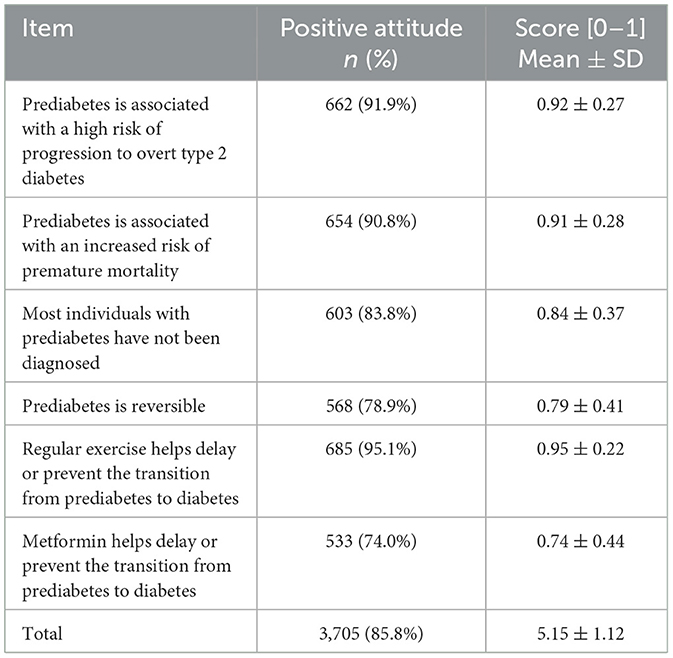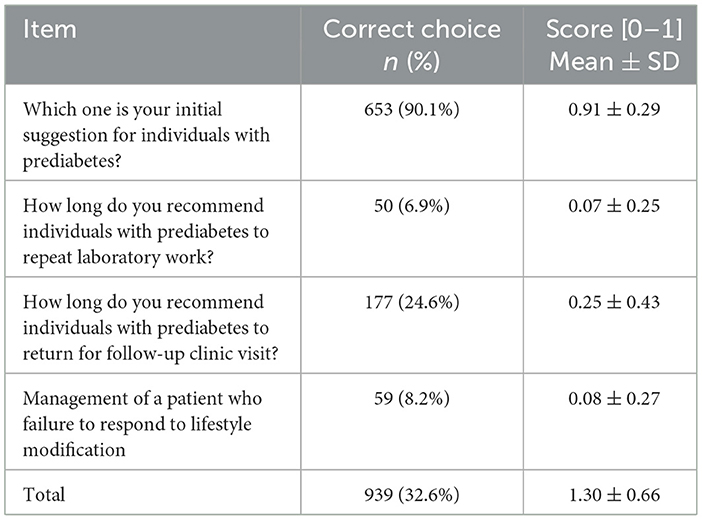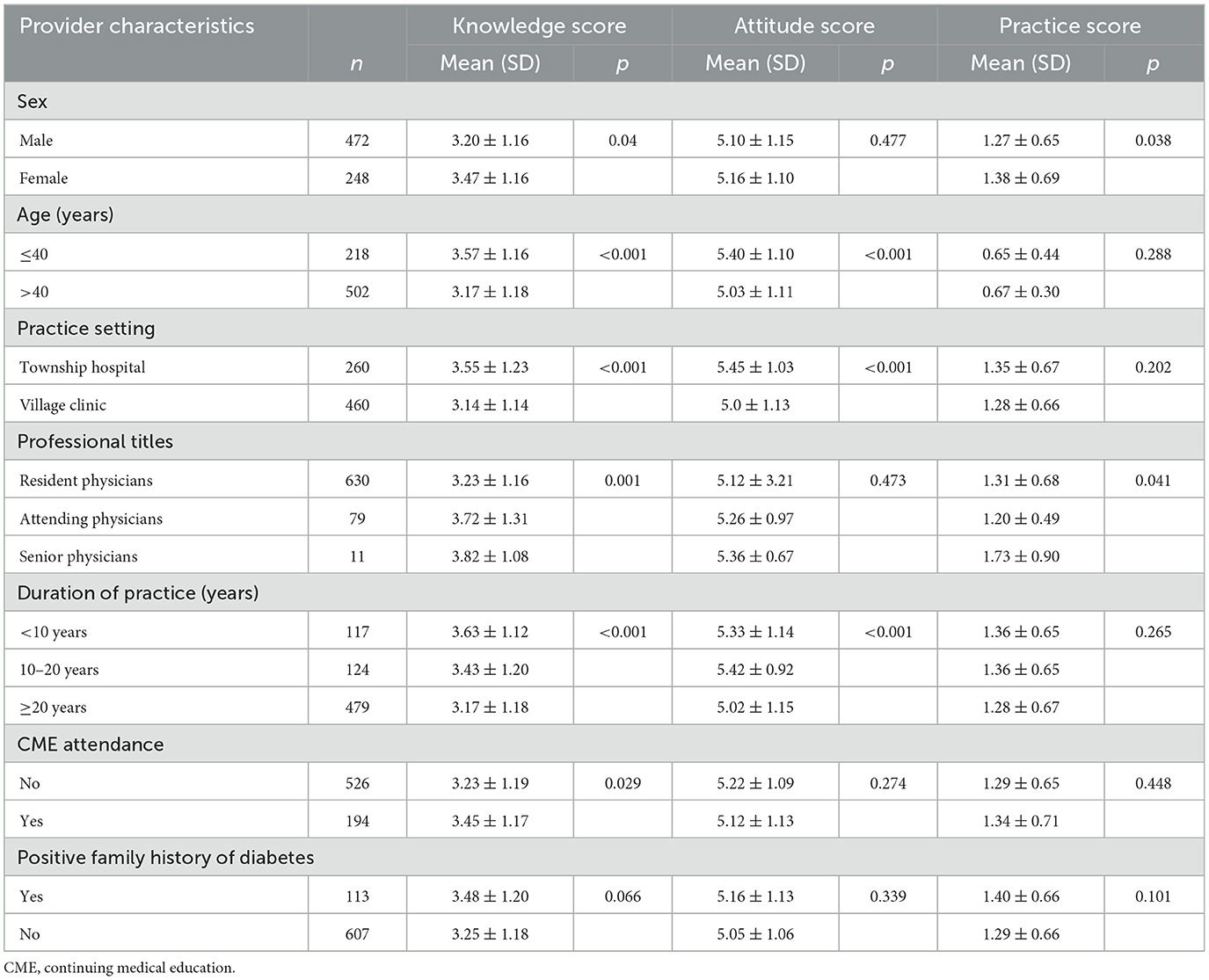- 1Department of Metabolism and Endocrinology, The Second Xiangya Hospital, Central South University, Changsha, China
- 2Key Laboratory of Diabetes Immunology (Central South University), Ministry of Education, Changsha, China
- 3National Clinical Research Center for Metabolic Diseases, Changsha, China
- 4Department of Metabolic Endocrinology, The First People's Hospital of Pingjiang, Yueyang, China
- 5Clinical Nursing Teaching and Research Section, The Second Xiangya Hospital of Central South University, Changsha, China
- 6Center for Medical Research, The Second Xiangya Hospital, Central South University, Changsha, China
Background: The management of prediabetes has great clinical significance, and primary care providers (PCPs) play important roles in the management and prevention of diabetes in China. Nevertheless, little is known about PCPs' knowledge, attitudes, and practices (KAP) regarding prediabetes. This cross-sectional study aimed to assess the KAP regarding prediabetes among PCPs in the Central China region.
Methods: This cross-sectional study was conducted using self-administered KAP questionnaires among PCPs from Central China region.
Results: In total, 720 PCPs completed the survey. Most physicians (85.8%) claimed to be aware of the adverse effects of prediabetes and reported positive attitudes toward prediabetes prevention, but the PCPs' knowledge of prediabetes and management practices showed substantial gaps. The prediabetes knowledge level and practice subscale scores of the PCPs were only 54.7% and 32.6%, respectively, of the corresponding optimal scores. Female PCPs showed higher prediabetes knowledge level scores (p = 0.04) and better practice scores (p = 0.038). Knowledge and attitude scores were inversely correlated with participants' age and duration of practice (p < 0.001). The PCPs who served in township hospitals had significantly higher knowledge and attitude scores than those who served in village clinics (p < 0.001). Furthermore, knowledge and practice scores increased with increasing professional titles. Recent continuing medical education (CME) attendance had a significant positive influence on knowledge of prediabetes (p = 0.029), but more than four-fifths of the surveyed PCPs did not participate in diabetes-related CME in the past year.
Conclusions: Substantial gaps were observed in PCPs' knowledge and practices regarding prediabetes in the Central China region. CME programmes were under-utilized by PCPs. Structured programmes are required to improve PCPs' prediabetes-related knowledge and practices in China.
Introduction
Prediabetes is a borderline glycaemic status presenting with impaired glucose metabolism that does not meet the diagnostic criteria for diabetes. According to the recent guidelines from the American Diabetes Association (ADA), prediabetes is defined by fasting plasma glucose (PG) level of 5.6–6.9 mmol/l, a 2-h PG level of 7.8–11.0 mmol/l in a 75-g oral glucose tolerance test (OGTT), and a hemoglobin A1c level of 5.7%−6.4% (1). A recent national survey indicated that the prevalence of prediabetes was 35.2% among adults living in China; thus, approximately 357 million Chinese have prediabetes (2). Furthermore, prediabetes is associated with a high risk of progression to overt type 2 diabetes (3) and may confer an increased risk of premature mortality (4, 5) and multiple chronic complications observed in established diabetes (6, 7). Numerous studies have confirmed that lifestyle interventions and medications are effective in delaying or preventing the development of diabetes (8–10).
Despite the success of preventive interventions, nearly 90% of individuals with prediabetes are not informed of their conditions by health providers (11) and most American patients with prediabetes do not receive appropriate interventions (12, 13). The situation in China may be worse, especially in the rural regions. Primary care physicians (PCPs) from townships or village doctors play a vital role in diabetes prevention by screening for and managing prediabetes. Thus, PCPs' knowledge of prediabetes and their attitudes and practices related to this condition are essential elements of prediabetes management. Previous studies conducted in the US (14, 15) and Latin America (16) indicated significant gaps in the knowledge of prediabetes among PCPs as well as inadequate detection and treatment of this condition by PCPs. Thus, understanding PCPs' knowledge, attitudes, and practices (KAP) related to prediabetes can facilitate the development of tailored strategies to improve knowledge, change attitudes, and address poor practices. To the best of our knowledge, PCPs' KAP related to prediabetes in China has not been described to date. Therefore, this study aimed to assess PCPs' knowledge of prediabetes as well as their attitudes toward prediabetes and prediabetes care practices in the Central China region. We also aimed to evaluate the association between provider characteristics and prediabetes-related KAP.
Methods
This cross-sectional study was conducted between May and August 2022. Letters of invitation were sent to PCPs from township hospitals or village doctors across Yueyang, Huaihua, and Yongzhou cities in Hunan Province, Central South China. Those who agreed to participate were provided with a questionnaire through an online platform in China, which provided functions equivalent to Amazon Mechanical Turk. This study was approved by the Ethics Committee of the Second Xiangya Hospital of Central South University, and written consent was obtained from each participant.
The self-administered questionnaire included multiple-choice and open-ended questions evaluating participants' prediabetes KAP and was developed in line with the concepts proposed by a Johns Hopkins University group (15). A pre-test was conducted among 10 PCPs to test the reliability and improve the clarity and interpretability of the questionnaire. The questionnaire consisted of two sections. The first section focused on PCPs' sociodemographic characteristics (sex and age), practice setting (township hospital or village clinic), physician seniority level, time since graduation in general medicine, history of diabetes in a first-degree relative, and experience of continuing medical education (CME) programmes related to diabetes in the past year. The second section was developed according to the latest ADA criteria and the Chinese Diabetes Society guidelines released in 2020 (17). It consisted of 16 questions on the participants' prediabetes-related knowledge (6 questions), attitudes (6 questions), and practices (4 questions). Questions related to knowledge and practice were evaluated using a two-point scale (1 = correct, 0 = false, and not sure). The questions related to attitude used a five-point Likert scale (1 = positive attitude, 0 = negative practice, or uncertain). Additionally, we asked providers to select what they considered significant challenges to lifestyle modification from a list of potential barriers drawn from prior studies regarding similar topics (14, 16) and asked them to list other possible potential barriers they encountered in daily clinical practice.
Statistical analyses
Data were extracted from the questionnaires and analyzed using SPSS version 25.0 (IBM Corporation, Chicago, IL, USA). Descriptive data were presented as numbers, percentages, means, and standard deviations, depending on whether the variables were categorical or continuous. The association between PCPs' characteristics and respondents' KAP was evaluated by Chi-square tests and t-tests, as appropriate. Multiple linear regression models were used to examine the association between the predictor variables and the KAP scores. Statistical significance was set at P < 0.05.
Results
Sociodemographic and other characteristics of the participants
This study enrolled 720 PCPs from the three cities in Hunan Province, Central China. The characteristics of the study participants are summarized in Table 1. The mean age of the participants was 44.7 ± 9.8 years. Among the participants, 65.5% were male, and 260 and 460 physicians worked in township hospitals and village clinics, respectively. The physicians involved in this study included 630 resident, 79 attending, and 11 senior physicians. Among them, 117 had practiced for < 10 years, 124 for 10–20 years, and 479 for >20 years. The majority (73.1%) of respondents had not participated in CME programmes related to diabetes in the past year, and 113 respondents had a family history of diabetes.
Physicians' knowledge regarding prediabetes
The participants were asked if they knew what prediabetes was and to identify the risk factors for diabetes. While 86.5% had adequate knowledge of the definition of prediabetes, 71.9% had sufficient knowledge of the risk factors for diabetes. However, the PCPs generally lacked knowledge of glycaemic cut-offs for the diagnosis of prediabetes, and only 50.4%, 56.4%, and 26.1% could identify the correct glycaemic cut-offs for diagnosing prediabetes based on the fasting glucose level, 2-h PG level during OGTT, and hemoglobin A1c level, respectively. Overall, only 62 of the 720 PCPs (8.6%) correctly identified all three glycaemic cut-off values for the diagnosis of prediabetes, while 116 PCPs (16.1%) were unaware of all three cut-off values. Less than half of the PCPs (37.5%) chose 5%−7% as the recommended minimum amount of weight loss (Table 2).
Physicians' attitudes toward prediabetes
Regarding attitudes toward prediabetes, more than 90% of the respondents deemed that prediabetes increased the risk of diabetes development and premature mortality, and more than 80% reported that most participants with prediabetes were unaware of their condition. Meanwhile, the majority of participants showed a positive attitude toward prediabetes prevention; 78.9% thought prediabetes was reversible through regular exercise and drugs (metformin) (Table 3).
Physicians' prediabetes-related practices
The overall practice score was low. Diet changes and physical activity were the most frequently employed methods for prediabetes management (90.1%), followed by repeat laboratory work and follow-up clinic visits for individuals with prediabetes. Fifty (6.9%) and 177 (24.6%) of the surveyed PCPs identified the right choices recommended by the ADA guidelines and Chinese expert consensus, respectively. Only 59 (8.2%) PCPs prescribed drugs (metformin, acarbose, etc.) to patients who failed to respond to lifestyle modification (Table 4).
Barriers to lifestyle modification
At the time of the survey, most PCPs selected lack of recognition of the harm posed by prediabetes (94.0%), lack of diet and exercise guidance (91.4%), uncertainty of the effectiveness of lifestyle modifications (88.5%), and lack of motivation (82.2%) as barriers to lifestyle modification. Additionally, 237 (23.9%) PCPs listed a lack of resources or financial limitations as a potential barrier in the open-ended question.
Correlations among KAP scores
The total mean scores for knowledge, attitude, and practice were 3.29, 5.15, and 1.30, respectively, out of possible scores of 6, 6, and 4, respectively. The knowledge and attitude scores showed a weak positive correlation (p = 0.001, r = 0.127), similar to the knowledge and practice scores (p = 0.004, r = 0.1107).
Factors associated with the overall KAP scores
The associations between the KAP scores and provider characteristics are presented in Table 5. Female PCPs reported significantly more prediabetes-related knowledge and practices than males. They also reported high mean attitude scores; however, the differences were not statistically significant. The knowledge and attitude scores varied significantly according to age; the lower age group showed higher scores, but with the practice score, the trend was reversed even though the difference was not statistically significant. Working in township hospitals was a significant predictor of higher knowledge and attitude scores.
Professional titles also showed statistically significant relationships with knowledge scores. The scores increased with increasing professional titles. The duration of practice was significantly associated with the knowledge and attitudes toward prediabetes. Respondents in the group with < 10 years of experience showed the highest knowledge score, whereas respondents in the group with 10–20 years of experience showed the highest attitude score. CME attendance during the past year had a significant positive influence on knowledge of prediabetes.
The joint effect of provider characteristics on KAP scores was evaluated using multiple regression analysis. Professional title was a significant provider characteristic that predicted the knowledge level of participants. Significant provider characteristics that predicted the attitude of participants were sex and the practice setting. However, none of the factors included in our study could predict the practice scores of the participants.
Discussion
To improve the management of diabetes and other chronic diseases, the Chinese government implemented the National Basic Public Health Services (BPHS) programme in 2009 (18). PCPs play a crucial role in this programme. The BPHS programme offers blood glucose tests, blood pressure measurements, lifestyle consultations, and medical instructions for people with diabetes. To provide a practical tool for doctors, especially for PCPs and general practitioners, The Chinese Diabetes Society released an expert consensus regarding prediabetes in 2020 (17). However, little is known about the competence of PCPs to perform this role. We conducted the first KAP study on prediabetes among Chinese PCPs from the Central China region. In the present study, most physicians (85.8%) claimed to be aware of the harmful effects of prediabetes and reported positive attitudes toward prediabetes prevention, but a substantial gap was noted in PCPs' knowledge of prediabetes and management practices. The PCPs' knowledge level for prediabetes was 54.7% of the optimal level, while their practice subscale score was 32.6% of the optimum score. Our findings showed that female PCPs had higher levels of prediabetes knowledge and better practices. The knowledge and attitude scores were inversely correlated with the participants' age and duration of practice. PCPs who served in township hospitals had significantly higher knowledge and attitude scores than those who served in village clinics. Furthermore, knowledge and practice scores increased with increasing professional titles. We also found that CME attendance in the past year had a significant positively influence on knowledge of prediabetes.
Our study revealed a suboptimal level of prediabetes knowledge regarding diagnostic criteria among PCPs, which may lead to low rates of identification of patients with prediabetes. Only 62 of the 720 PCPs (8.6%) correctly identified all three glycaemic cut-off values for the diagnosis of prediabetes, and 16.1% were not aware of any of the glycaemic cut-off values for prediabetes diagnosis. Our findings were comparable with those obtained by other researchers in America (14, 15) and Latin America (16) who also reported large gaps in prediabetes knowledge among PCPs. While ~90% of individuals with prediabetes in the US are not informed of their conditions by healthcare providers (11), the situation in China is expected to be much worse. The low awareness of prediabetes could be partly attributed to the lack of optimal knowledge of prediabetes among PCPs. We also found that PCPs lacked knowledge of evidence-based recommendations for prediabetes. Weight loss is the most important factor in reducing the risk of incident diabetes, and evidence suggests that 5%−7% weight loss is sufficient to achieve this goal (19–21). Knowledge of this weight-loss target is essential for providing lifestyle consultations for patients with prediabetes. Previous studies have demonstrated that most patients with prediabetes do not receive appropriate interventions (12, 13). In our study, only 37.5% of respondents correctly identified the guideline recommendations for weight loss; addressing this knowledge gap may improve the management of prediabetes. We also observed that PCPs with a younger age and a shorter duration of practice possessed a higher level of knowledge than their counterparts. A previous study also showed that the diabetes knowledge of Iranian internists was inversely correlated with the participants' age and duration of practice (22). This could be attributed to the fact that younger PCPs are more likely to keep abreast with the current trends in prediabetes. An important finding of our study was that participation in CME regarding diabetes could significantly improve PCPs' prediabetes knowledge, which is in accordance with previous studies regarding diabetes knowledge among PCPs (23–25). However, more than four-fifths of the surveyed PCPs had not participated in CME regarding diabetes in the past year. Although many CME programs are available for PCPs, they are under-utilized. One possible reason might be the COVID pandemic preventing the in-person participation. As a newly emerging technology, telemedicine has demonstrated enormous potential to provide an effective intervention in health care (26, 27). To this end, telemedicine may be a feasible approach for overcome part of barriers during the COVID-19 pandemic period.
The current study indicated that most of the respondents deemed that prediabetes increased the risk of development of diabetes and premature mortality, and more than 80% believed that most patients with prediabetes were unaware of their condition. Meanwhile, the majority had a positive attitude toward prediabetes prevention: 78.9% thought prediabetes was reversible through regular exercise and drugs (metformin). Similar to the findings for the knowledge subscale, the overall attitude scores were inversely correlated with the participants' age and duration of practice, which could also be due to the fact that younger PCPs are more likely to keep abreast with current trends in prediabetes. Moreover, PCPs who served in township hospitals had significantly higher attitude scores than those who served in village clinics, which could be because PCPs, who served in township hospitals had greater accessibility to the latest medical knowledge.
We found some poor practices related to prediabetes among PCPs. In our survey, only 24.6% and 6.9% of the PCPs reported familiarity with the Chinese expert consensus, which recommends the interval for clinical follow-up and repeat laboratory assessments (17). Thus, very few PCPs were aware of the expert consensus, and addressing this problem may improve delivery of care for prediabetes. In a Diabetes Prevention Program study, lifestyle modification or metformin treatment was proven to be effective in reducing the incidence of diabetes and the risk of microvascular complications (9, 28). However, consistent with the results of previous studies (14–16), very few PCPs considered metformin use for prediabetes. This may be due to skepticism regarding the effectiveness of metformin (29).
The PCPs identified a lack of diet and exercise guidance as well as resource or financial limitations as important system-level barriers, and patient-related factors such as lack of recognition of prediabetes, uncertainty regarding the effectiveness of lifestyle modification, and lack of motivation as barriers to lifestyle modification. Therefore, goal-oriented measurements to tackle these barriers will be key to cost-effective management of prediabetes.
Limitations
The present study had several limitations. First, this study was conducted among PCPs from the Central China region; due to variations in geographical and sociocultural characteristics across China, the results may not be generalizable. Second, the results of the KAP survey were self-reported by the participants, which may have introduced recall and social desirability biases, with more respondents reporting positive attitudes toward prediabetes.
Conclusion
This study highlighted the substantial gaps in knowledge and practices regarding prediabetes among PCPs in the Central China region. The results also indicated underutilisation of prediabetes CME programmes by PCPs. Since PCPs play a crucial role in the prevention and management of diabetes, efforts to address these gaps in prediabetes knowledge and practice are of urgent importance. Structured programmes should be planned to improve prediabetes-related knowledge and practices among PCPs in China. In view of this, we make the following suggestions:
1. Educating providers on expert consensus regarding prediabetes, online education may be a candidate approach.
2. Develop a simplified prediabetes management algorithm by Chinese Diabetes Society.
Data availability statement
The raw data supporting the conclusions of this article will be made available by the authors, without undue reservation.
Ethics statement
The studies involving human participants were reviewed and approved by the Ethics Committee of the Second Xiangya Hospital of Central South. The patients/participants provided their written informed consent to participate in this study.
Author contributions
XS and ZW designed the study. LP, DF, and YZ collected the data. LP conducted the data analysis and drafted the manuscript. XS, ZW, and ZZ revised the manuscript. JY carefully edited the revised manuscript. All authors read and approved the submitted version of the manuscript.
Funding
This research was supported by National Natural Science Foundation of China (Grant No. 82000798), Hunan Province Natural Science Foundation of China (Grant Nos. 2021JJ40863 and 2022JJ30851), and the Science and Technology Innovation Program of Hunan Province (Grant No. 2022RC1010).
Conflict of interest
The authors declare that the research was conducted in the absence of any commercial or financial relationships that could be construed as a potential conflict of interest.
Publisher's note
All claims expressed in this article are solely those of the authors and do not necessarily represent those of their affiliated organizations, or those of the publisher, the editors and the reviewers. Any product that may be evaluated in this article, or claim that may be made by its manufacturer, is not guaranteed or endorsed by the publisher.
Supplementary material
The Supplementary Material for this article can be found online at: https://www.frontiersin.org/articles/10.3389/fpubh.2023.1086147/full#supplementary-material
References
1. American Diabetes Association Professional Practice Committee and American Diabetes Association Professional Practice Committee. 2. Classification and diagnosis of diabetes: standards of medical care in diabetes-2022. Diabetes Care. (2022) 45(Suppl 1):S17–38. doi: 10.2337/dc22-S002
2. Li Y, Teng D, Shi X, Qin G, Qin Y, Quan H, et al. Prevalence of diabetes recorded in mainland China using 2018 diagnostic criteria from the American Diabetes Association: national cross sectional study. BMJ. (2020) 369:m997. doi: 10.1136/bmj.m997
3. Tabák AG, Herder C, Rathmann W, Brunner EJ, Kivimäki M. Prediabetes: a high-risk state for diabetes development. Lancet. (2012) 379:2279–90. doi: 10.1016/S0140-6736(12)60283-9
4. Gong Q, Zhang P, Wang J, An Y, Gregg EW Li H, et al. Changes in mortality in people with IGT before and after the onset of diabetes during the 23-year follow-up of the da qing diabetes prevention study. Diabetes Care. (2016) 39:1550–5. doi: 10.2337/dc16-0429
5. Rao Kondapally Seshasai S, Kaptoge S, Thompson A, Di Angelantonio E, Gao P, Sarwar N, et al. Diabetes mellitus, fasting glucose, and risk of cause-specific death. N Engl J Med. (2011) 364:829–41. doi: 10.1056/NEJMoa1008862
6. Huang Y, Cai X, Mai W, Li M, Hu Y. Association between prediabetes and risk of cardiovascular disease and all-cause mortality: systematic review and meta-analysis. BMJ. (2016) 355:i5953. doi: 10.1136/bmj.i5953
7. Echouffo-Tcheugui JB, Narayan KM, Weisman D, Golden SH, Jaar BG. Association between prediabetes and risk of chronic kidney disease: a systematic review and meta-analysis. Diabet Med. (2016) 33:1615–24. doi: 10.1111/dme.13113
8. Knowler WC, Fowler SE, Hamman RF, Christophi CA, Hoffman HJ, Brenneman AT, et al. 10-year follow-up of diabetes incidence and weight loss in the Diabetes Prevention Program Outcomes Study. Lancet. (2009) 374:1677–86. doi: 10.1016/S0140-6736(09)61457-4
9. Knowler WC, Barrett-Connor E, Fowler SE, Hamman RF, Lachin JM, Walker EA, et al. Reduction in the incidence of type 2 diabetes with lifestyle intervention or metformin. N Engl J Med. (2002) 346:393–403. doi: 10.1056/NEJMoa012512
10. Diabetes Prevention Program Research Group. Long-term effects of lifestyle intervention or metformin on diabetes development and microvascular complications over 15-year follow-up: the Diabetes Prevention Program Outcomes Study. Lancet Diabetes Endocrinol. (2015) 3:866–75. doi: 10.1016/S2213-8587(15)00291-0
11. Centers for Disease Control and Prevention. National Diabetes Statistics Report, 2017. Atlanta, GA: Centers for Disease Control and Prevention, US Department of Health and Human Services (2017).
12. Karve A, Hayward RA. Prevalence, diagnosis, and treatment of impaired fasting glucose and impaired glucose tolerance in nondiabetic US adults. Diabetes Care. (2010) 33:2355–9. doi: 10.2337/dc09-1957
13. Schmittdiel JA, Adams SR, Segal J, Griffin MR, Roumie CL, Ohnsorg K, et al. Novel use and utility of integrated electronic health records to assess rates of prediabetes recognition and treatment: brief report from an integrated electronic health records pilot study. Diabetes Care. (2014) 37:565–8. doi: 10.2337/dc13-1223
14. Tseng E, Greer RC, O'Rourke P, Yeh HC, McGuire MM, Albright AL, et al. National survey of primary care physicians' knowledge, practices, and perceptions of prediabetes. J Gen Intern Med. (2019) 34:2475–81. doi: 10.1007/s11606-019-05245-7
15. Tseng E, Greer RC, O'Rourke P, Yeh HC, McGuire MM, Clark JM, et al. Survey of primary care providers' knowledge of screening for, diagnosing and managing prediabetes. J Gen Intern Med. (2017) 32:1172–8. doi: 10.1007/s11606-017-4103-1
16. Garay J, Camacho PA, Lopez-Lopez J, Alvernia J, Garcia M, Cohen DD, et al. Survey of knowledge for diagnosing and managing prediabetes in Latin-America: cross-sectional study. Diabetol Metab Syndr. (2019) 11:102. doi: 10.1186/s13098-019-0500-4
17. Chinese Chinese Society of Endocrinology Chinese Diabetes Society Chinese Endocrinologist Association Endocrine Endocrine and Metabolic Disease Branch of Chinese Research Hospital Association Diabetes Diabetes Branch of Chinese Research Hospital Association. Intervention for adults with pre-diabetes: a Chinese expert consensus. Chin J Endocrinol. (2020) 36:371–80. doi: 10.3760/cma.j.cn311282-20200115-00022
18. National Health and Family Planning Commission. Notice of the National Health and Family Planning Commission on printing and distributing the national basic public health service standard (Third Edition) China. Beijing: National Health and Family Planning Commission, PRC (2017).
19. Maruthur NM, Ma Y, Delahanty LM, Nelson JA, Aroda V, White NH, et al. Early response to preventive strategies in the Diabetes Prevention Program. J Gen Intern Med. (2013) 28:1629–36. doi: 10.1007/s11606-013-2548-4
20. Hamman RF, Wing RR, Edelstein SL, Lachin JM, Bray GA, Delahanty L, et al. Effect of weight loss with lifestyle intervention on risk of diabetes. Diabetes Care. (2006) 29:2102–7. doi: 10.2337/dc06-0560
21. PCC Care. Prevention or delay of type 2 diabetes and associated comorbidities: standards of medical care in diabetes-2022. Diabetes Care. (2022) 45(Suppl 1):S39–S45. doi: 10.2337/dc22-S003
22. Niroomand M, Ghasemi SN, Karimi-Sari H, Khosravi MH. Knowledge, attitude, and practice of Iranian internists regarding diabetes: a cross sectional study. Diabetes Metab J. (2017) 41:179–86. doi: 10.4093/dmj.2017.41.3.179
23. Khan AR, Al Abdul Lateef ZN, Khamseen MB, Al Aithan MA, Khan SA, Al Ibrahim I. Knowledge, attitude and practice of ministry of health primary health care physicians in the management of type 2 diabetes mellitus: a cross-sectional study in the Al Hasa District of Saudi Arabia, 2010. Niger J Clin Pract. (2011) 14:52–9. doi: 10.4103/1119-3077.79241
24. Aghili R, Malek M, Baradaran HR, Peyvandi AA, Ebrahim Valojerdi A, Khamseh ME. General practitioners' knowledge and clinical practice in management of people with type 2 diabetes in Iran; the impact of continuous medical education programs. Arch Iran Med. (2015) 18:582–5.
25. Alduraibi RK, Almigbal TH, Alrasheed AA, Batais MA. Knowledge, attitudes, and practices of primary health care physicians regarding the pre-travel counselling of patients with type 2 diabetes in Riyadh, Saudi Arabia. BMC Fam Pract. (2020) 21:200. doi: 10.1186/s12875-020-01273-z
26. Mahmoud K, Jaramillo C, Barteit S. Telemedicine in low- and middle-income countries during the COVID-19 pandemic: a scoping review. Front Public Health. (2022) 10:914423. doi: 10.3389/fpubh.2022.914423
27. Jafarzadeh-Esfehani R, Mirzaei Fard M, Habibi Hatam-Ghale F, Rezaei Kalat A, Fathi A, Shariati M, et al. Telemedicine and computer-based technologies during coronavirus disease 2019 infection; a chance to educate and diagnose. Arch Iran Med. (2020) 23:561–3. doi: 10.34172/aim.2020.60
28. Diabetes Prevention Program Research Group. Long-term safety, tolerability, and weight loss associated with metformin in the Diabetes Prevention Program Outcomes Study. Diabetes Care. (2012) 35:731–7. doi: 10.2337/dc11-1299
Keywords: prediabetes, KAP, primary care providers, China, cross-sectional study
Citation: Pi L, Yan J, Fei D, Zheng Y, Shi X, Wang Z and Zhou Z (2023) Primary care providers' knowledge, attitudes, and practices related to prediabetes in China: A cross-sectional study. Front. Public Health 11:1086147. doi: 10.3389/fpubh.2023.1086147
Received: 01 November 2022; Accepted: 03 February 2023;
Published: 23 February 2023.
Edited by:
Christiane Stock, Charité Medical University of Berlin, GermanyReviewed by:
Chu Lin, Peking University People's Hospital, ChinaHeng Su, The First People's Hospital of Yunnan Province, China
Copyright © 2023 Pi, Yan, Fei, Zheng, Shi, Wang and Zhou. This is an open-access article distributed under the terms of the Creative Commons Attribution License (CC BY). The use, distribution or reproduction in other forums is permitted, provided the original author(s) and the copyright owner(s) are credited and that the original publication in this journal is cited, in accordance with accepted academic practice. No use, distribution or reproduction is permitted which does not comply with these terms.
*Correspondence: Xiajie Shi,  Ym9iLXhpYWppZUBjc3UuZWR1LmNu; Zhen Wang,
Ym9iLXhpYWppZUBjc3UuZWR1LmNu; Zhen Wang,  d2FuZ3poZW5jc0Bjc3UuZWR1LmNu
d2FuZ3poZW5jc0Bjc3UuZWR1LmNu
 Linhua Pi
Linhua Pi Jianru Yan4
Jianru Yan4 Xiajie Shi
Xiajie Shi Zhen Wang
Zhen Wang Zhiguang Zhou
Zhiguang Zhou